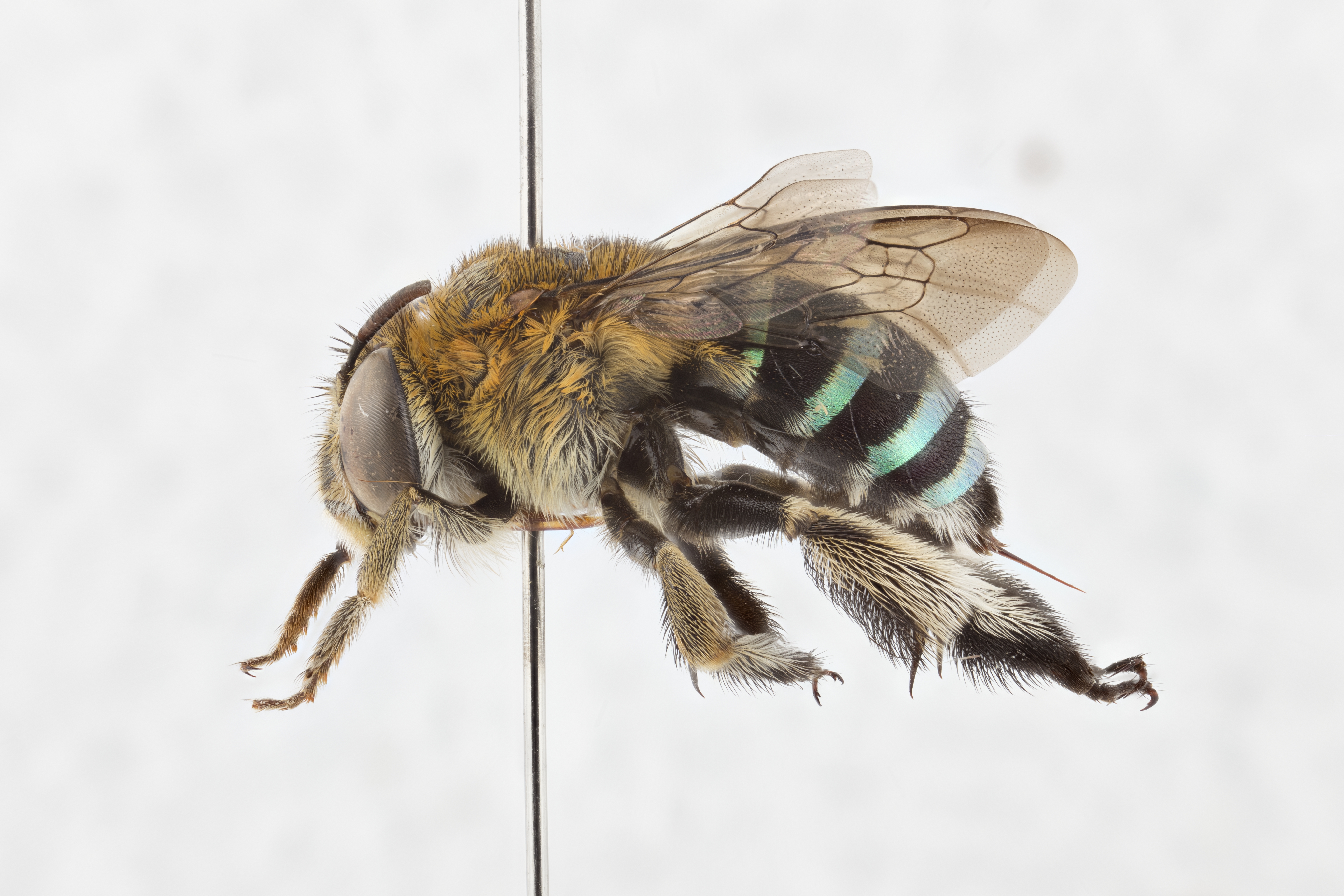 |
| Fig 1. The Blue-banded bee (Photo: Chua Si Hao) |
Introduction
When one thinks of bees, the image that comes to mind is that of the typical honey bee, with its trademark black and yellow abdomen. However, there is a large variety of bees that do not follow this form, of which many can be found in Singapore. One such example is the Blue-banded bee (Amegilla zonata) which, as its name suggests, has blue bands on its abdomen instead of yellow.“Blue-banded bee” can actually refer to many different species within the genus Amegilla which share this characteristic blue banding. Amegilla spp. are found strictly in the Old World [1], ranging throughout Australia, Asia, Europe and Africa, with currently 252 species described [2]. They are largely similar to and can be confused with bees of genus Anthophora, but Amegilla is easily differentiated by its lack of arolia, which are padlike projections between the tarsal claws [3].
Due to the relatively large distribution and snumber of species in Amegilla, it is further divided into 11 subgenera. Amegilla zonata is placed in subgenus Zonamegilla, and is the type species of this subgenus [1].
Through this webpage, I hope to be able to showcase a remarkable and unique bee species in Singapore, and show that not all bees are like the more commonly known honey bee.
Name
Binomial name: Amegilla zonataVernacular name: Blue-banded bee
Synonyms:
Apis zonata Linnaeus, 1758
Anthophora zonata (Bingham, 1897; Friese, 1918)
Anthophora zonata var. puttalama (Strand, 1913)
Amegilla (Zonamegilla) zonata (Brooks, 1988)
Etymology
The species name zonata is derived from the Latin “zonatus”, which means either “belted” or “zoned”. This likely refers to the distinct metallic-blue bands on its abdomen. Its common name directly refers to this feature on the abdomen as well.Characteristics
Diagnosis
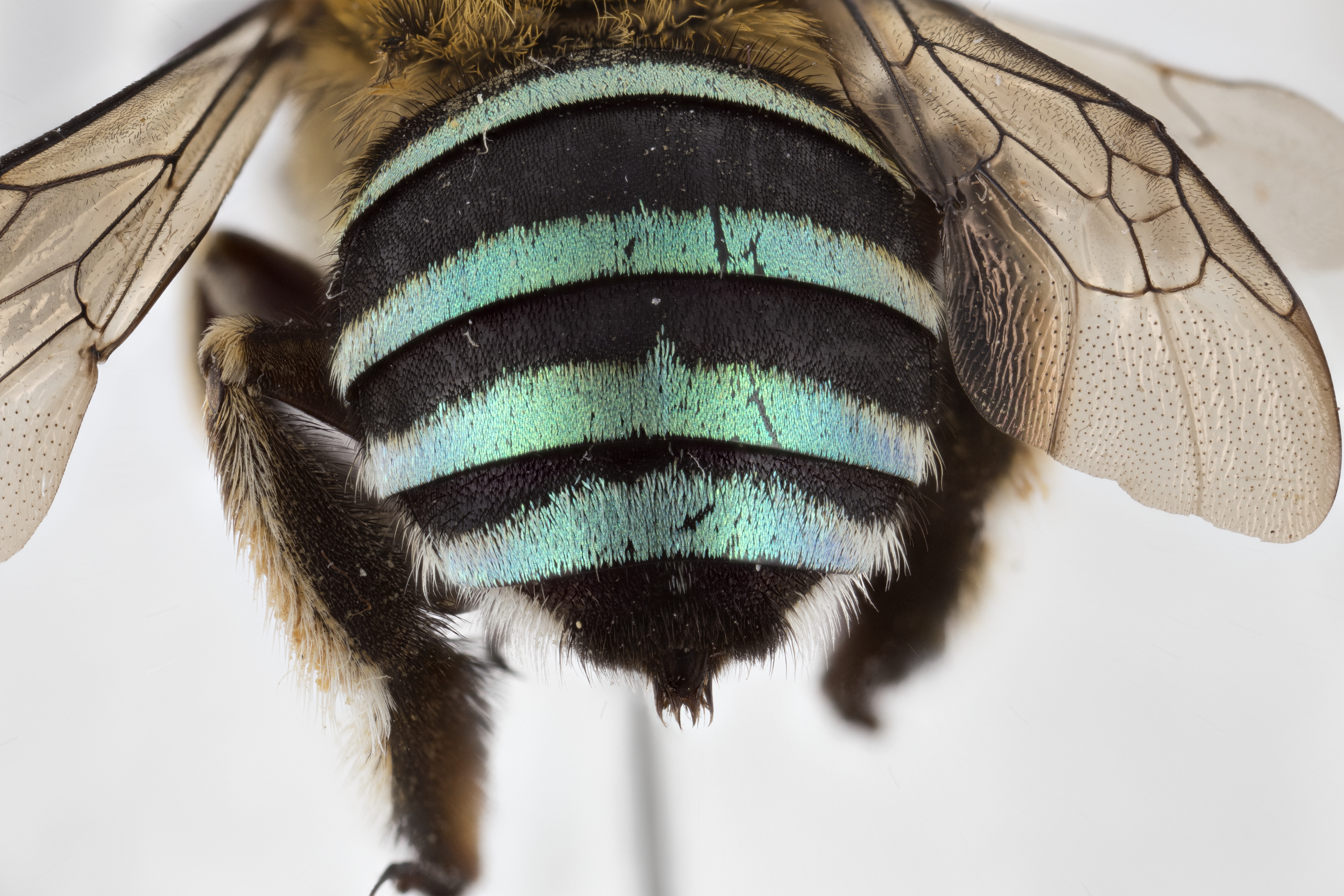 |
| Fig 2. Metallic-blue hair on abdominal segments 1-4 (Photo: Chua Si Hao) |
The following characteristics can be used to differentiate Amegilla zonata from other bees, whether in Amegilla or other genera [1][4]. For reference, a diagram showcasing the morphology of a typical bee can be found here.
- 11-13mm in length.
- Seven exposed metasomal terga,
- Apical margins of abdominal segments 1-4 covered in metallic blue hair (see Fig 2)
- Yellow markings along labrum, clypeus, base of mandibles, and medial line across head (see Fig 3)
- Brown, short hairs on thoracic segments (see Fig 3)
- Apex of final abdominal segment bilobed
- Apex of (male) gonostyle quadrate, bent inwards (see Fig 4)
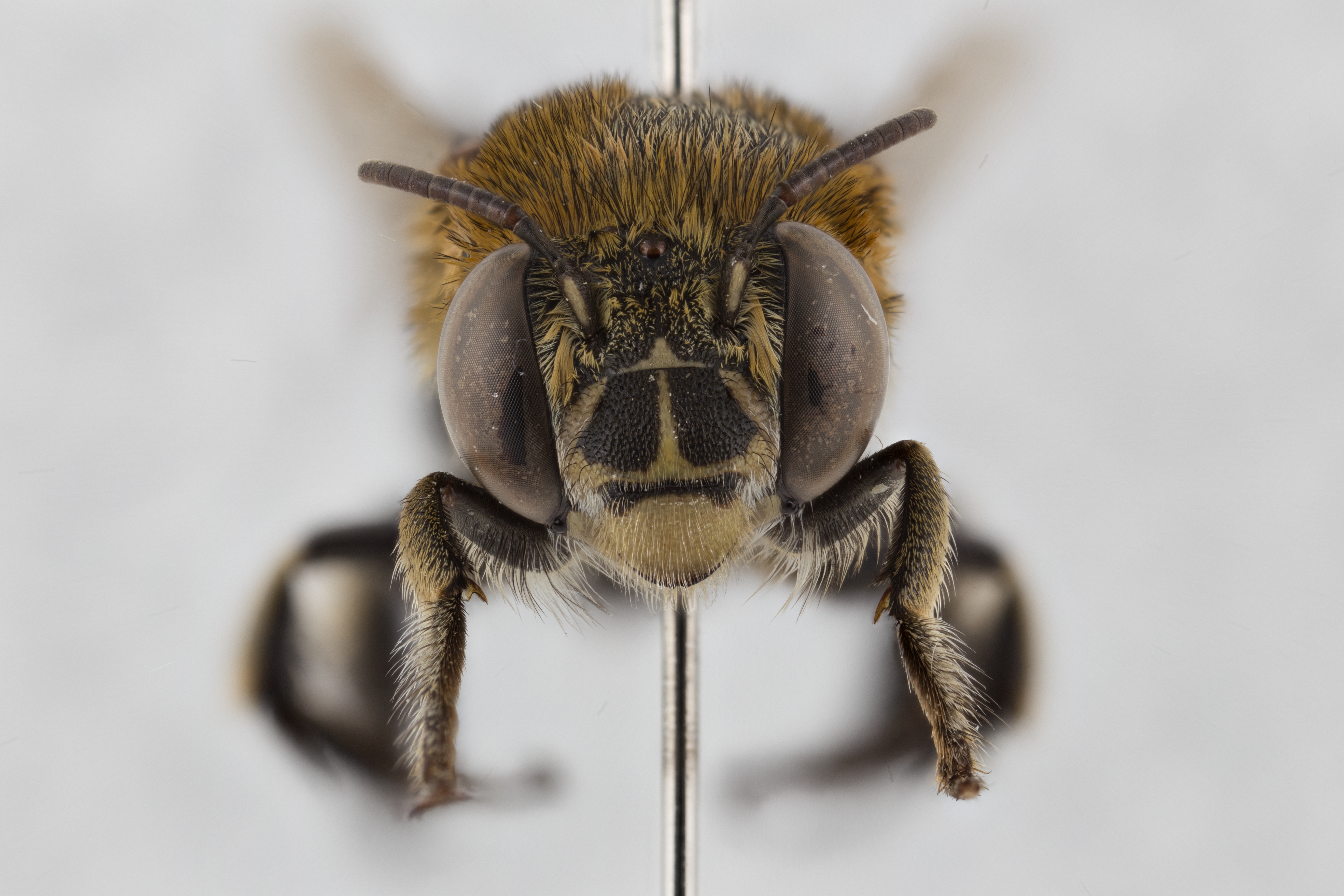 |
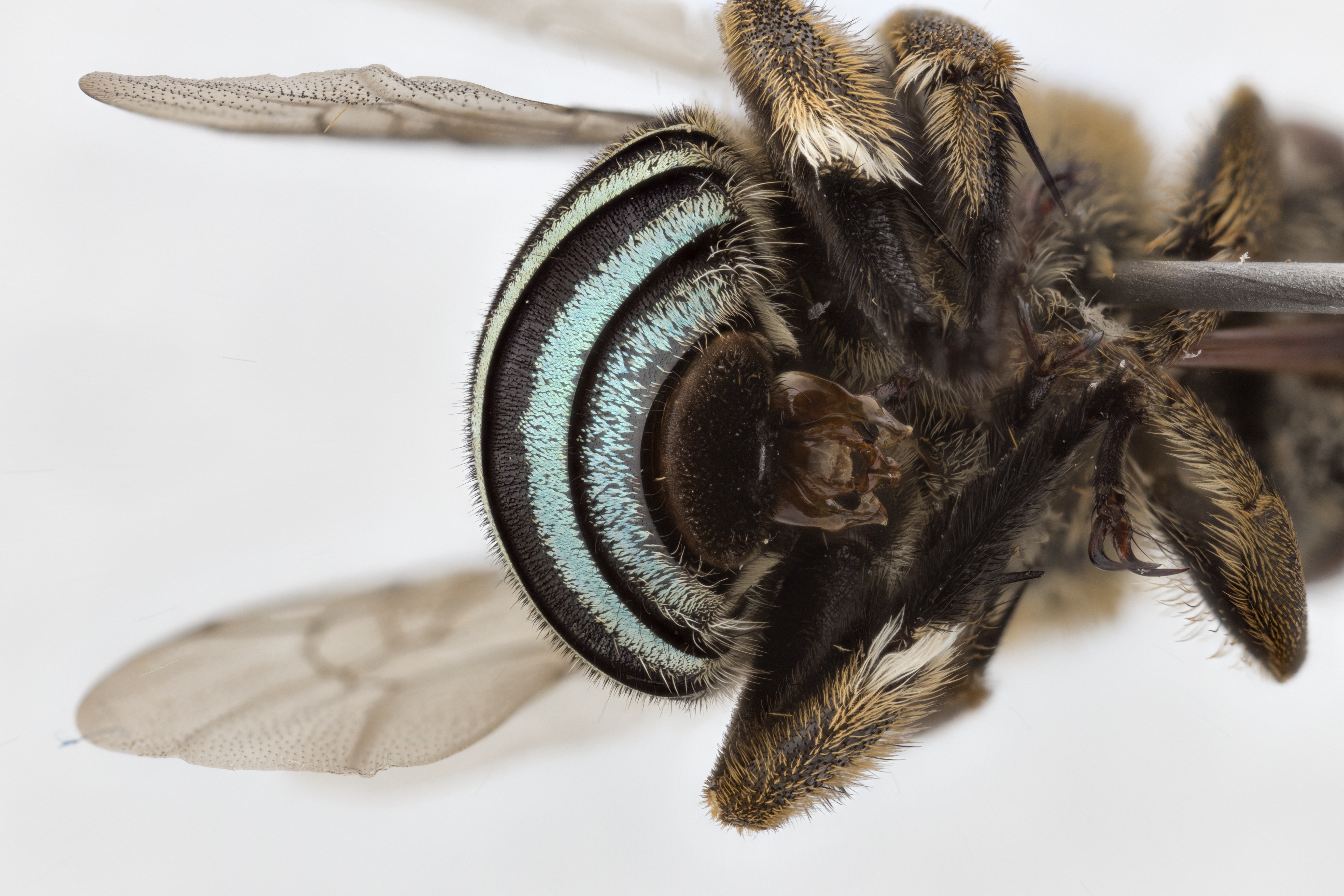 |
|
| Fig 3. Yellow markings across the head, brown short hairs on thorax (Photo: Chua Si Hao) |
Fig 4. Quadrate gonostyle on the male (Photo: Chua Si Hao) |
Comparison with A. korotonensis
Amegilla zonata shares many resemblances to other Amegilla spp., particularly those in subgenus Zonamegilla. In Singapore, we are able to find one other species of Amegilla, namely Amegilla korotonensis. Fortunately, these two species are relatively easy to differentiate through the following characteristics:| Characteristic |
A. zonata |
A. korotnensis |
| Size |
Relatively larger |
Relatively smaller |
| Abdomen |
Relatively larger |
Relatively smaller, rounder |
| Blue bands |
Darker, more metallic shade of blue |
Lighter shade of blue |
| Hind legs |
White hairs stretch from hind femur to tibia |
White hairs only found on tibia |
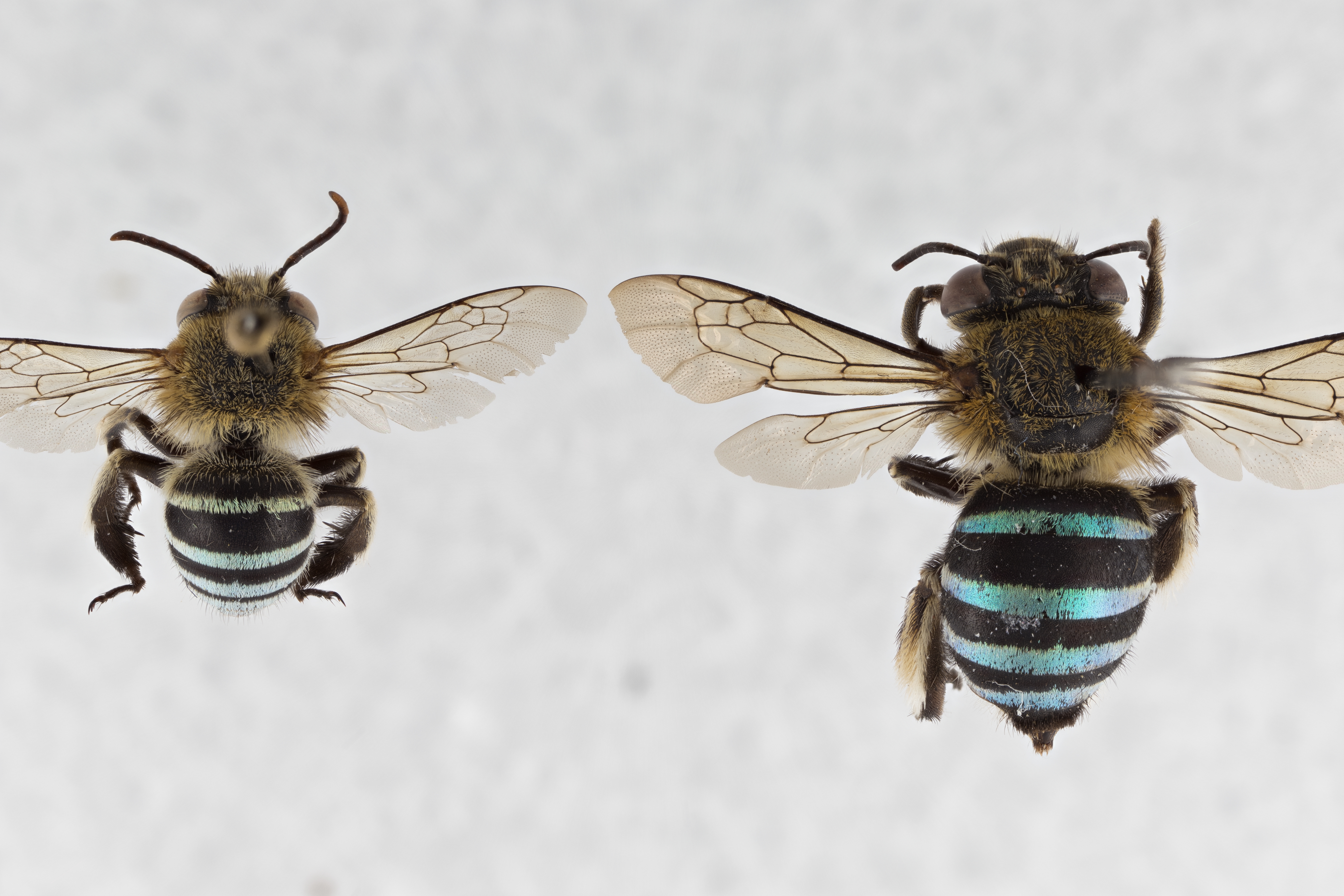 |
| Fig 5. A. korotonensis (left) and A. zonata (right). We can see the difference in size and abdomen banding in this comparison. (Photo: Chua Si Hao) |
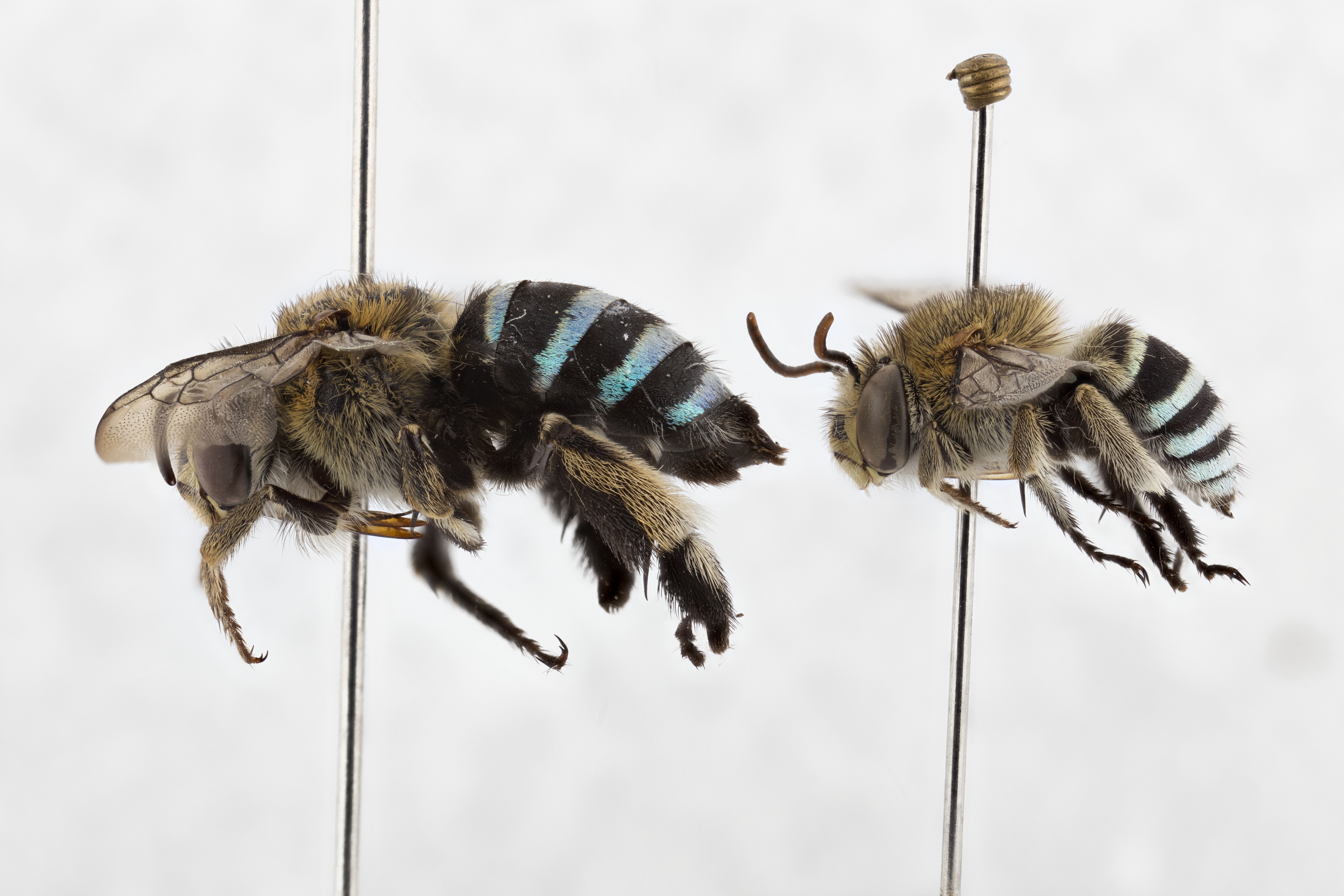 |
| Fig 6. A. zonata (left) and A. korotonensis (right). The difference in white hairs on their hind limbs is clear here. (Photo: Chua Si Hao) |
Description
Original description by Carl Linnaeus (1758) [5]:“A. subpubescens fusca, abdomine cingulis quatuor caeruleis. Habitat in Indiis.”, which translates to “brown, short pubescence; four blue abdominal belts. Habitat in Indies”.
Biology
Feeding
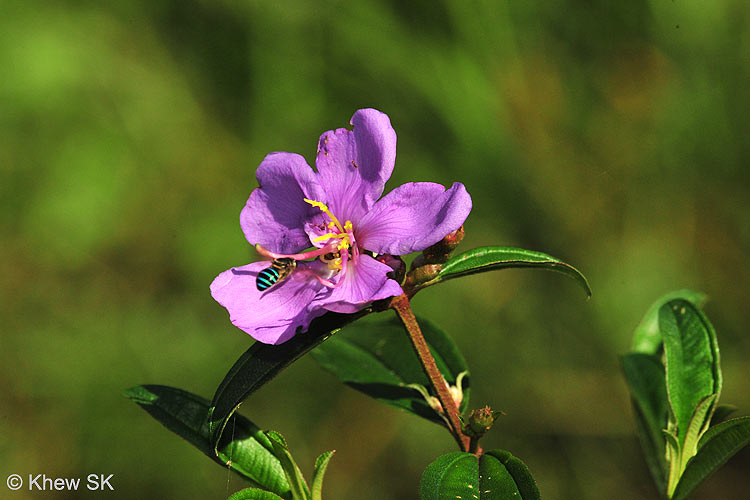 |
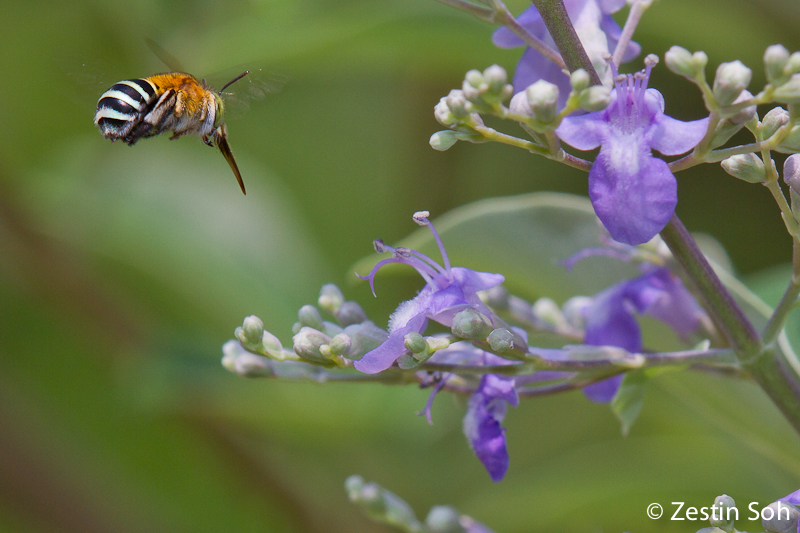 |
| Fig 7. Amegilla zonata performing buzz pollination on a Melostama malabathricum flower (Photo: Khew S K, used with permission) |
Fig 8. Amegilla zonata showcasing its long proboscis (Photo: Zestin Soh, used with permission) |
Amegilla zonata employs buzz pollination in order to obtain pollen from flowers, a method not employed by honey bees. This involves grabbing onto the anthers of the flowers and vibrating the wing muscles at the right frequency to dislodge the pollen [6][7]. We can see an example of buzz pollination in Video 1. The pollen is then gathered on the hairs of the hind legs of the bee[8]. A. zonata is also able to use its relatively long proboscis to feed on nectar at the base of the flower [9], which can be seen in Video 2.
| Video 1. Amegilla sp. performing buzz pollination |
Video 2. Amegilla sp. using its proboscis to feed on nectar |
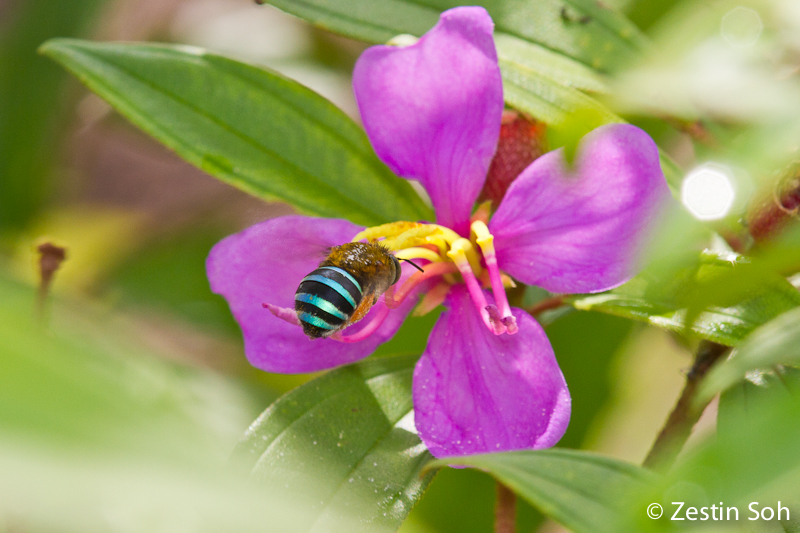 |
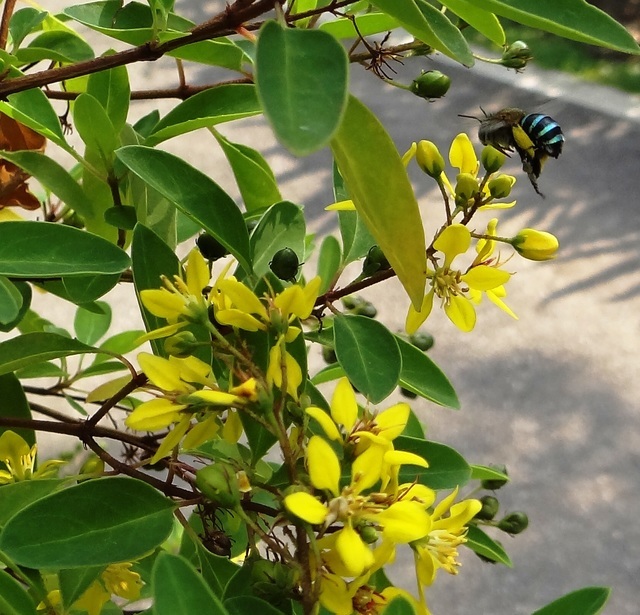 |
| Fig 9. Amegilla zonata with Melostama malabathricum (Photo: Zestin Soh, used with permission) |
Fig 10. Amegilla zonata with Galphimia glauca (Photo: J. S. Ascher) |
Ecosystem service
Amegilla zonata serves an important role in most ecosystems by pollinating various flowers. It has been found to be especially important in tropical rainforest understories, which lack the large quantities of eusocial bees normally found in forest canopies [9]. Bees like A. zonata are particularly important as their target flowers may not be able to be pollinated without this buzz pollination. Many of these flowers even form specific relationships with their respective pollinators, further highlighting the importance of A.zonata in such forest settings.Amegilla spp. have also been found to be effective at pollinating crop plants, such as tomatoes, under greenhouse settings. Such an ecosystem service would allow us to cultivate certain crops in Singapore and slightly alleviate our reliance on importing food. This also removes the need to import potentially invasive bees, such as honey bees or bumblebees, as A. zonata can be readily found in Singapore [6].
Nesting
While the honey bees typically construct nests with hexagonal honeycomb cells, Blue-banded bees do things differently. Like most Anthophorine bees, Amegilla zonata builds its nest by burrowing into the soil [3]. While they are solitary bees, they often nest together in nearby burrows [11]. Various bees of Amegilla spp. may even be seen nesting together [1]. It has been suggested that pheromones released from the Dufour’s gland into the excavated soil may attract other females to nest [12][13]. Aggregated nesting appears to lend an advantage against destruction, predation, or parasitism [14]. Individuals have even been found returning to successful nesting sites of previous generations [15], highlighting the relative advantage such aggregations provide.The burrows branch into individual cells, which are lined by secretions from the Dufour’s gland that later solidify into a waxy layer [16]. The female then lays an individual egg into each cell, depositing it onto a provision of nectar and pollen. The female then closes up the cell with more of the waxy lining. The nectar, pollen, and even the waxy lining act as food for the larvae when it emerges. We can contrast this with the honey bee, which uses the nectar it collects to create honey, which is then fed to its larvae [3]. One might argue that the pollen and nectar mixture that A. zonata produces reflects a rudimentary form of honey production in Anthophorine bees.
Males, on the other hand, do not nest in burrows, nor do they assist in the excavation. Instead, males rest on plant stems by grabbing on with their mandibles [17]. We can see this behavior in Video 3.
| Video 3. Male Amegilla sp. roosting on grass stems |
Associated parasites
Amegilla bees are known to be targeted by kleptoparasitic Thyreus spp., commonly known as Cuckoo bees [18][3]. In Singapore, A. zonata faces parasitism from Thyreus himalayensis and ceylonicus[19][20]. Thyreus bees break into the cells of the host nest, oviposit in it, and seal it back up with earth. The larvae then hatch and take advantage of the food deposited by the female A. zonata [3]. Thyreus bees also possess blue markings and bandings on their abdomen, which may serve as a form of camouflage against Amegilla. This has led some to propose that Thyreus may have evolved from a common ancestor as Amegilla, hence their similar colouration and associations, although this hypothesis lacks strong evidence thus far [3].| Fig 11. Thyreus himalayensis (Photo © www.NatureLoveYou.sg, used with permission) |
Fig 12. Thyreus ceylonicus, which can be differentiated from T. himalayensis by a break in the horizontal band of blue hair across the abdomen (Photo © www.NatureLoveYou.sg, used with permission) |
Besides Thyreus spp., Amegilla spp. have been observed to be parasitized by insects from other Orders, such as Diptera (Miltogramma sp.) and Coleoptera (Zonitis sp., Trogoderma apicenne, Lusioderma serricorne). Some cells have even been found with fungal colonies that feed on the deposited food and the larvae itself [18].
Distribution
Global distribution
Amegilla zonata have been described to be found throughout India, Myanmar, Sri Lanka, extending through the Malayan peninsula to Australia [4]. There have also been records as far north China and Taiwan, however these may be misidentifications as many Zonamegilla species share strong resemblance [21]. |
| Fig 13. Map showing global distribution of A. zonata [22] |
Local distribution
Amegilla zonata can be found at the locations in the below map. Data is obtained from National University of Science Bee Lab (collected by J. S. Ascher, S. H. Chua, S. X. Chui, K. Y. Ng, Z. W. W. Soh, E. J. Y. Soh, J. W. T. Tan, and K. S. Yow). As we can see, A. zonata can be found at many parks and secondary forests ranging throughout Singapore, so keep a look out for them the next time you are in a park or our nature reserves.Taxonomic classification
Kingdom Animalia
Phylum Arthropoda
Subphylum Hexapoda
Class Insecta
Order Hymenoptera
Family Apidae
Tribe Anthophorini
Genus Amegilla (Friese, 1897)
Subgenus Zonamegilla (Popov, 1950)
Species Amegilla zonata (Linnaeus, 1758)
Phylogeny
The phylogenetic relationship of various genera and subgenera under the Tribe Anthophorini is displayed below [23]. It showcases the close relationship between Amegilla and Anthophora, explaining their similar general morphology. It also shows a close but undefined relationship between subgenera Zebramegilla, Glossamegilla, and Zonamegilla (including A. zonata).
| Fig 14. Phylogeny of Tribe Anthophorini, obtained from Dubitzky, 2007 |
References
- Brooks, R. W. (1988). Systematics and phylogeny of the anthophorine bees (Hymenoptera: Anthophoridae; Anthophorini). The University of Kansas science bulletin (USA).
- ITIS (2010). Amegilla zonata (Linnaeus, 1758). Retrieved November 4, 2014, from http://www.itis.gov/servlet/SingleRpt/SingleRpt?search_topic=TSN&search_value=762797
- Michener, C. D. (2000). The bees of the world (Vol. 1). JHU Press.
- Bingham, C. T., & Morley, C. (1897). Hymenoptera.. (Vol. 1). Taylor & Francis.
- Linnaeus, C. (1758). Systema Naturae, Ed. 10, vol. 1. 824 pp. Salvii, Holmiae.
- Hogendoorn, K., Coventry, S., & Keller, M. A. (2007). Foraging behaviour of a blue banded bee, Amegilla chlorocyanea in greenhouses: implications for use as tomato pollinators. Apidologie, 38(1), 86-92.
- De Luca, P. A., & Vallejo-Marín, M. (2013). What's the ‘buzz’about? The ecology and evolutionary significance of buzz-pollination. Current opinion in plant biology, 16(4), 429-435.
- BioNET-EAFRINET. (2011). Amegilla bees. Retrieved November 4, 2014, from http://keys.lucidcentral.org/keys/v3/eafrinet/bee_genera/key/african_bee_genera/Media/Html_eafrica/Amegilla_bees.htm
- Kato, M. (1996). Plant-pollinator interactions in the understory of a lowland mixed dipterocarp forest in Sarawak. American Journal of Botany, 732-743.
- Murali, S., Dhananjaya, P., Reddy, G. N., & Vinayaka, T. (2013). Study of insect pollinator's diversity in Asystasia gangetica (L.). Environment and Ecology, 31(2A), 804-806.
- Alcock, J. (1999). The nesting behavior of Dawson's burrowing bee, Amegilla dawsoni (Hymenoptera: Anthophorini), and the production of offspring of different sizes. Journal of insect behavior, 12(3), 363-384.
- Cardale, J. C. (1968). Nest and nesting behaviour of Amegilla (Amegilla) Pulchra (Smith)(Hymenoptera: Apoidea: Anthophorinae). Australian Journal of Zoology, 16(4), 689-707.
- Cane, J. H. (1981). Dufour's gland secretion in the cell linings of bees (Hymenoptera: Apoidea). Journal of chemical ecology, 7(2), 403-410.
- Potts, S., & Willmer, P. A. T. (1997). Abiotic and biotic factors influencing nest‐site selection by Halictus rubicundus, a ground‐nesting halictine bee.Ecological Entomology, 22(3), 319-328.
- Michener, C. D. (1969). Comparative social behavior of bees. Annual review of entomology, 14(1), 299-342.
- Batra, S. W. T. (1972). Some properties of the nest-building secretions of Nomia, Anthophora, Hylaeus and other bees. Journal of the Kansas Entomological Society, 208-218.
- Australian Native Bee Research Centre. (n.d.). Blue Banded Bee (Amegilla). Retrieved November 4, 2014, from http://www.aussiebee.com.au/blue_banded_bee.html
- Cardale, J. (1968). Parasites and other organisms associated with nests of Amegilla Friese (Hymenoptera: Anthophorinae). Australian Journal of Entomology, 7(1), 29-34.
- Ascher, J. (n.d.). Thyreus ceylonicus (Friese, 1905). Retrieved November 4, 2014, from http://www.discoverlife.org/mp/20q?search= Thyreus+ceylonicus
- Ascher, J. (n.d.). Thyreus himalayensis (Radoszkowski, 1893). Retrieved November 4, 2014, from http://www.discoverlife.org/mp/20q?search= Thyreus+himalayensis
- Engel, M. S. (2007). A new Amegilla of the zonata group from Malaysia and Thailand (Hymenoptera: Apidae). Transactions of the Kansas Academy of Science, 110(1), 16-22.
- Ascher, J. (n.d.). Amegilla zonata (Linnaeus, 1758). Retrieved November 4, 2014, from http://www.discoverlife.org/mp/20q?search=Amegilla+zonata
- Dubitzky, A. (2007). Phylogeny of the World Anthophorini (Hymenoptera: Apoidea: Apidae). Systematic Entomology, 32(4), 585-600.